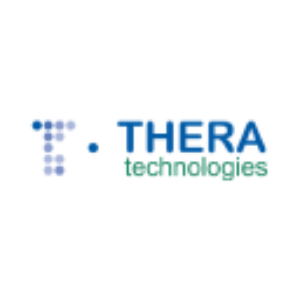Theratechnologies Presents Novel Data at ACTHIV 2025 Underscoring Importance of Managing Excess Visceral Abdominal Fat (EVAF) in People with HIV
Rhea-AI Summary
Positive
- First-of-its-kind case series showed high success rate (6/7 patients) in treating EVAF with combination therapy
- Combination therapy demonstrated significant reductions in key metrics: weight (-13 lbs), BMI (-2.2 kg/m2), waist circumference (-3.4 inches)
- VAMOS study provided valuable insights into EVAF's relationship with muscle quality in HIV patients
Negative
- High prevalence (58%) of EVAF found in study participants
- EVAF strongly correlates with reduced skeletal muscle quality in HIV patients
News Market Reaction 1 Alert
On the day this news was published, THTX declined 5.14%, reflecting a notable negative market reaction.
Data tracked by StockTitan Argus on the day of publication.
VAMOS analysis highlights link between EVAF and reduced muscle quality
Case series reports success with combination tesamorelin/GLP-1 receptor agonist therapy
MONTREAL, May 02, 2025 (GLOBE NEWSWIRE) -- Theratechnologies Inc. (“Theratechnologies” or the “Company”) (TSX: TH) (NASDAQ: THTX), a commercial-stage biopharmaceutical company, today announced two poster presentations at the 19th Annual American Conference for the Treatment of HIV (ACTHIV 2025), taking place May 1-3 in Chicago, Ill. Both presentations focus on issues surrounding excess visceral abdominal fat (EVAF), a common comorbidity in people with HIV (PWH).
One poster presents a new analysis of data from the Visceral Adiposity Measurement and Observations Study (VAMOS), in which EVAF was associated with reduced muscle quality in aging PWH. VAMOS is the first trial designed to improve the understanding of the impact of EVAF on cardiovascular disease, steatotic liver disease, insulin resistance, and other metabolic parameters in PWH. The second presentation reports on a first-of-its-kind case series in which the combination of tesamorelin and glucagon-like peptide-1 (GLP-1) receptor agonist (RA) therapy was highly effective in reducing both EVAF and obesity in a real-world setting.
“We are proud to continue our exploration into the complexities of excess visceral abdominal fat in people with HIV,” said Christian Marsolais, Ph.D., Senior Vice President and Chief Medical Officer of Theratechnologies. “As people with HIV live longer, analyses such as the data we are presenting at ACTHIV are critical to addressing this population’s evolving health needs. Our research adds to the growing understanding that body composition, most importantly EVAF, is a key factor in aging-related functional decline in HIV, and we are committed to investigating this complex relationship.”
VAMOS Analysis
Poster Title: Reduced Muscle Quality is Highly Prevalent in Aging People with HIV (PWH) and is Associated with Excess Visceral Abdominal Fat (EVAF)
First Author: Zachary Henry, DO, AIDS Healthcare Foundation, Fort Lauderdale, Fla.
In the latest analysis from the multicenter VAMOS study, researchers investigated how EVAF, compared to subcutaneous fat, is associated with muscle quality in PWH on modern anti-retroviral regimens, and explored potential drivers of this relationship. Among the 170 participants, EVAF prevalence was
Tesamorelin/GLP-1 RA Case Series
Poster Title: High Levels of Treatment Success Seen with Combined Use of Tesamorelin and GLP1-RAs in People with HIV
First Author: Daniel Lee, MD, University of California San Diego Department of Medicine, San Diego, Calif.
In the case series, investigators reported on the real-world use of tesamorelin for the treatment of EVAF in PWH, in combination with GLP-1 RAs, which are commonly used for diabetes and obesity management in the general population. Among the seven PWH evaluated in the case series, tesamorelin was initiated first in all cases to address EVAF, with a mean reduction in waist circumference of 1.3 inches. The principal reasons for adding a GLP-1-RA included improving BMI and diabetic control. Following at least six months of combination therapy, patients saw mean reductions in weight (-13 pounds), BMI (-2.2 kg/m2), and waist circumference (-3.4 inches), with six of the seven patients achieving their metabolic and body composition goals. Combination therapy is ongoing in most of the patients (6/7). This is the first known report of the dual use of these agents in PWH, highlighting their complementary but distinct mechanisms of action.
“The combination of tesamorelin and GLP-1 medications represents a new frontier in metabolic care for people with HIV,” noted Dr. Marsolais. “By distinguishing between and targeting both excess visceral abdominal fat and generalized obesity, treatment strategies can be tailored to address the specific needs of people living with HIV.”
Both posters can be found at www.theratech.com and www.acthiv.org following the conference.
About Theratechnologies
Theratechnologies (TSX: TH) (NASDAQ: THTX) is a specialty biopharmaceutical company focused on the commercialization of innovative therapies that have the potential to redefine standards of care. Further information about Theratechnologies is available on the Company's website at www.theratech.com, on SEDAR+ at www.sedarplus.ca and on EDGAR at www.sec.gov. Follow Theratechnologies on LinkedIn and X.
Forward-Looking Information
This press release contains forward-looking statements and forward-looking information (collectively, the “Forward-Looking Statements”), within the meaning of applicable securities laws, that are based on our management’s beliefs and assumptions and on information currently available to our management. You can identify Forward-Looking Statements by terms such as "may", "will", "should", "could", “promising”, “would”, "outlook", "believe", "plan", "envisage", "anticipate", "expect" and "estimate", or the negatives of these terms, or variations of them. The Forward-Looking Statements contained in this press release include, but are not limited to, statements regarding the Company’s commitment to investigate the relationship between body composition and aging and the tailoring of treatment strategies for PWH. Forward-looking statements involve a number of assumptions, risks and uncertainties. Some of these assumptions include, but are not limited to, the duration of treatment and the responses to the administered drugs by PWH. Some of the risks include that PWH may not respond similarly when they take medicines and results may differ from what those were observed and reported through VAMOS and the tesamorelin/GLP-1 RA case series. The Company refers current and potential investors to the “Risk Factors” section of the Company’s Annual Information Form filed on Form 20-F dated February 26, 2025 available on SEDAR+ at www.sedarplus.ca and on EDGAR at www.sec.gov under Theratechnologies’ public filings for the risks associated with the business of Theratechnologies. The reader is cautioned to consider these and other risks and uncertainties carefully and not to put undue reliance on forward-looking statements. Forward-Looking Statements reflect current expectations regarding future events and speak only as of the date of this press release and represent the Company’s expectations as of that date.
The Company undertakes no obligation to update or revise the information contained in this press release, whether as a result of new information, future events or circumstances or otherwise, except as may be required by applicable law.
Contacts:
Media inquiries:
Julie Schneiderman
Senior Director, Communications & Corporate Affairs
communications@theratech.com
514-336-7800
Investor Inquiries:
Joanne Choi
Senior Director, Investor Relations
jchoi@theratech.com
551-261-0401









